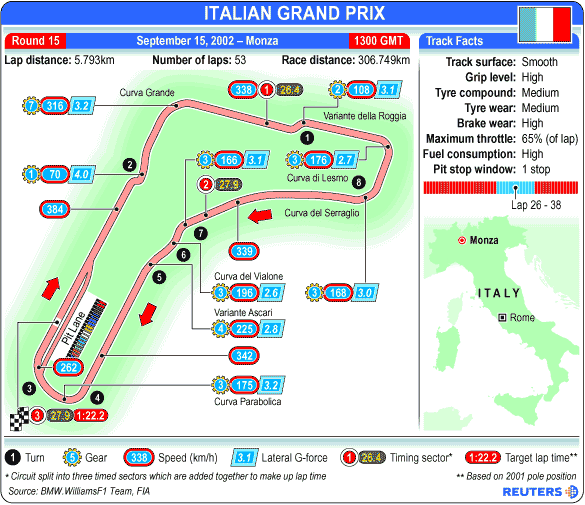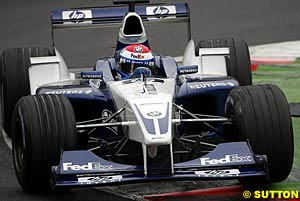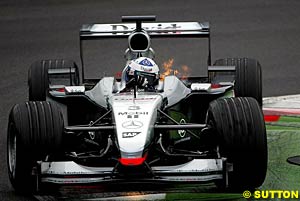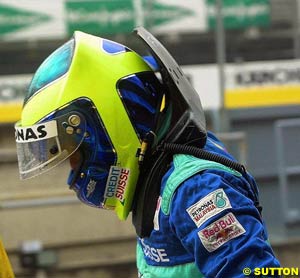
Atlas F1 Technical Writer
Monza, one of the last few fast and old fashioned European tracks, will host this weekend's Italian Grand Prix for the 53rd time. It will be a celebration time for the Tifosi, but it will also be a testing event for the engineers and their machinery. Craig Scarborough reviews the upcoming weekend
The circuit design is firmly set in the past, with a classic European layout that favours top speed. Chicanes have been added to introduce a safety element, but Monza is still the track that sees the cars run flat out for the longest.
Also unique to Monza, is the fact that the FIA allows the teams to test at the circuit a week before the race. Therefore, last week saw all the active teams arrive at Monza for a major four-day test - only the Silverstone test in July matches the scale of this one.
Ten teams (Arrows were not present) participated in the test with their race and test drivers, in order to gather data and test components specifically for Monza. Rain interrupted the sessions but did allow the tyre manufacturers to get some accurate running on their latest wet weather tyres.
Set-up and Layout
Monza's layout is quite simple and is all about flowing flat out curves. The start/finish straight runs down to a chicane, before turning right for another straight ended by another chicane. Then, another right turn, and a longer straight ending by the last chicane and capped by the 180 degree Parabolica turn.
This simplistic layout demands nothing but outright power and minimum drag from the cars in order to gain the most speed on the straights. There are also less crucial requirements from the cars for braking performance and mechanical compliancy, to ride over the kerbs in the chicanes and give grip to accelerate out of the chicanes.
With the long straights the cars are at a maximum speed of over 340 km/h three times around the lap, with the overall longest open throttle of any circuit at over 65% of the lap. With this focus so purely on top speed, the teams will opt to run the smallest wings possible to reduce drag and add to top speed.
The low downforce set-up makes the cars less stable for the three big braking zones. Maximising the mechanical set-up will improve this performance, as will the tyre construction - both tyre manufacturers have special tyres specifically for this circuit.
The heavy braking required requires the team to run as large a brake duct as possible, which subsequently means that overshooting the chicane on the brakes during the race can lead to a drive through penalty in the pitlane.
Overall, the set-up favours the car rather than the driver. On Sunday, the grid is likely to be a two by two affair, unless a driver has had a troublesome qualifying session.
Overtaking is possible on this track, generally by slipstreaming the leading car and out-braking it into the next chicane. These overtaking opportunities are beneficial as the pit strategy is likely to be universally a one stop only through the 53 lap race. This necessitates a heavy fuel load, but as tyre wear is so low there is little to be gained from fresh tyres and multiple stops.
With the high speeds attained at Monza, and if there is hot weather, tyres can overheat and the resulting blisters can be a serious stability problem. Monza is one of the few tracks where the tyre manufacturers are allowed to "buff" the tyre, which is the process of shaving off a small amount of the rubber from the inside shoulder to reduce the likelihood of blistering.
Team by team
Ferrari
The Italian team go to their home Grand Prix as favourites, after a 1-2 finish in Spa two weeks ago and successful tests last week. The team tested on two fronts; Luca Badoer tested at a sunny Paul Ricard circuit in France, while the two race drivers were at the colder and wetter Monza circuit. The Paul Ricard test was rumoured to have been for the 2003 car, with Badoer testing various parts, but it was more likely for tyre testing in warmer climates, on a circuit not dissimilar to Monza.
Rubens Barrichello cannot secure his second place in the World Drivers' Championship this weekend, but a finish ahead of his rivals would put him in a mathematically commanding position to take the placing at Indianapolis. Michael Schumacher still seems to want to stamp his authority as Spa demonstrated, so he will be pushing hard for his eleventh win this season - and a record fourth at the Monza track.
Williams
With their race and test drivers present at the testing session last week, Williams were able to test a new front wing, designed purely for the high speed circuit. The wing eschews the dipped centre section adopted earlier this year and actually rises in the centre. This "anhedral" shape produces less downforce and drag and also allows the underbody of the car to work more efficiently, crucially allowing the team to run less rear wing.
McLaren
What is expected at Monza, is the new wing seen in testing, similar in principle to the Williams "anhedral" wing. The McLaren design is even more shaped with raised ends as well as a raised centre section.
After a strong showing at Spa, McLaren clearly have the power and mechanical poise to be competitive in Monza. If the car can match its tyres in the race, both Coulthard and Raikkonen will be capable of their usual aggressive overtaking manoeuvres into the chicanes.
Renault
Testing at Monza allowed Renault to confirm the performance of some new aerodynamic parts for the race, as well as evaluate tyres and set-up. However, the test was punctuated with several engine failures, which - bearing in mind the team's poor lead over Sauber in the Championship due to engine failures in prior races - should be worrying.
The Renault engine is also low on power, limiting top speed, so their usual great starts may place them ahead of their rivals but they will be easier to overtake than has been the case on recent circuits.
Sauber
There was one incident in testing, however, that looked worrying: a failure of the engine cover, which came loose and triggered the on-board fire extinguisher. Engine covers flying off on a busy circuit or in the race can have serious safety repercussions.
Sauber have long campaigned on safety issues and plan to run the full weekend with the new HANS (head and neck support) systems installed. This system is made up of a brace that attaches to the helmet and is fastened under the seat belts to limit head movement during a crash.
Jordan
Monza was the scene of Jordan's last win, in 1999, but even with a new specification Honda engine the team cannot be that confident this year. The team ran the new engine in testing and were positive about its power delivery, if not the reliability which is still suspect.
The team expect to run well on the high speed straights with a low downforce derivative of their front wing. Takuma Sato is looking for reliability and some luck to bring him his first points of the year, and the race is team leader's Giancarlo Fisichella's home race.
BAR
BAR brought two cars and four drivers to the Monza test. Minardi stand-in driver Anthony Davidson was back in action as test driver and was joined by the two race drivers and Frenchman Patrick Lemarie. The test was for both race preparation and to assess the new Honda engine, which blew up losing time on one of the days.
Last year saw a good result with points for the team and this year, the drivers are hopeful for a competitive showing, should reliability permit it.
Jaguar
Both race drivers tested at Monza and were happy that the car was working well on its low downforce set-up. Constant development of the car has brought its competitiveness up, but the drivers are still dependant on the performance of the Michelin tyres to bring them strong results.
Toyota
Toyota also went testing with two cars and four drivers, the usual test drivers of Stephane Sarrazin and Ryan Briscoe joining the race drivers. Among the jobs on the worksheet for the testing force was a slimmed down front wing, matched to the smaller rear wing already seen this year.
While the drivers were confident of the engine power and low downforce for the long straights, it is riding over kerbs which is the continual weak spot for the TF102. This issue was worked on and "significant progress" was made during the test.
After a strong start to the season, Toyota have struggled as of late. Monza will be the ideal place for Mika Salo to get a good finish at one of his favourite circuits and for Allan McNish to prove his race craft in his bid for an F1 drive next year.
Minardi
The Fiorano test was the first for F1 cars since the track was resurfaced in August, and the team chose to run a 2001 car with Russian Sergey Zlobin and Italian Euro F3000 driver Matteo Bobbi for comparison. Minardi are to be sponsored by a Russian petrochemical company for next year, explaining the test drive for the relatively unknown Zlobin.
The Monza test involved David Saelens, Alex Yoong, and Mark Webber. Yoong was returning to the car after his three-race break, having failed to qualify for several races this year. He will also be back in the race car at the upcoming Grands Prix.
With the freely supplied Asiatech engine having little development this year, the team will be struggling to match the straight line pace of the rest of the field, even with a cut down version of their front wing reducing drag as much as possible. This leaves the drivers with little chance of doing anything but following the field around on Sunday, should both drivers qualify.
Arrows
The Arrows team have cited force majeure as reason for missing the last couple Grands Prix, and are now asking for the FIA to consider their case despite the fact that they are not planning to attend the Italian Grand Prix, while the team owners continue to work out their finances with their investors.
This weekend's Italian Grand Prix will mark the 80th anniversary and 53rd running of the race at Monza - one of the most historic circuits on the calendar and with some of the most fervent supporters in the crowd.

 Juan Pablo Montoya in his Williams was able to take pole position and the race win on Ferrari's home ground last year, as the power of the BMW engine and the Michelins worked to perfection in the hot race. This year, however, his teammate Ralf Schumacher is not so certain the package has the same advantage. "Normally the high speed track is good for us, but we believed the same before the Belgian Grand Prix," he said recently. Either way, Williams will most likely have both drivers pushing Ferrari in the race and/or qualifying, but are not expected to dominate.
Juan Pablo Montoya in his Williams was able to take pole position and the race win on Ferrari's home ground last year, as the power of the BMW engine and the Michelins worked to perfection in the hot race. This year, however, his teammate Ralf Schumacher is not so certain the package has the same advantage. "Normally the high speed track is good for us, but we believed the same before the Belgian Grand Prix," he said recently. Either way, Williams will most likely have both drivers pushing Ferrari in the race and/or qualifying, but are not expected to dominate.
 McLaren ran testing on two circuits last week, with David Coulthard testing at Monza in preparation for the race, while Kimi Raikkonen and test driver Alex Wurz were running the new gearbox at Silverstone. The new rear end will not be used in Monza but is expected for Indianapolis.
McLaren ran testing on two circuits last week, with David Coulthard testing at Monza in preparation for the race, while Kimi Raikkonen and test driver Alex Wurz were running the new gearbox at Silverstone. The new rear end will not be used in Monza but is expected for Indianapolis.
 Another race which is forecast to be good for Sauber - the team have solved the set-up mysteries that afflicted their Spa weekend and go to Monza after a positive test.
Another race which is forecast to be good for Sauber - the team have solved the set-up mysteries that afflicted their Spa weekend and go to Monza after a positive test.
 Minardi are not frequent testers during the season due to lack of funds, but last week the team tested at both Fiorano and Monza with no less than five drivers.
Minardi are not frequent testers during the season due to lack of funds, but last week the team tested at both Fiorano and Monza with no less than five drivers.
Please Contact Us for permission to republish this or any other material from Atlas F1.
|
Volume 8, Issue 37
Articles
Juan & Kimi: The Odd Couple
Giancarlo Fisichella: Through the Visor
Jo Ramirez: a Racing Man
Italian GP Preview
Italian GP Preview
Local History: Italian GP
Italy Facts, Stats and Memoirs
Columns
Italian GP Quiz
Rear View Mirror
Bookworm Critique
Elsewhere in Racing
The Grapevine
> Homepage |